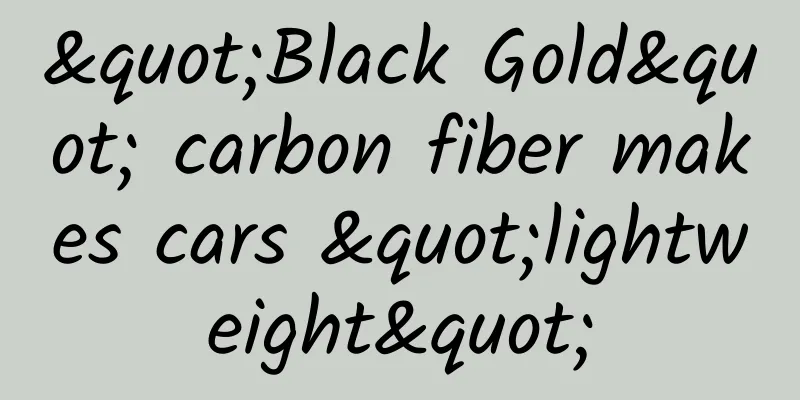"Black Gold" carbon fiber makes cars "lightweight"

|
The battery box occupies an important position in the structure of new energy vehicles. While providing effective energy and power for new energy vehicles, the battery box assembly is too heavy due to the relatively small charge of a single battery and the large number required, which will affect the acceleration performance and maximum speed of the vehicle. At present, the total weight of the battery box itself accounts for 30% to 35% of the total weight of the car. Since the total weight of the battery box itself consumes a large amount of battery efficiency, reducing the weight of the battery box has become a top priority for the development of new energy vehicles. Since the battery boxes of electric vehicles have always been made of steel materials with excellent fatigue resistance, and the application development technology has become increasingly mature, some experts have studied the strength analysis of the battery boxes of many vehicles under different working conditions, and optimized the design and improvement of the battery boxes, improving the stress concentration on the local structure and improving the structural strength. Although experts have optimized the structure of electric vehicle battery boxes, they still cannot change the fact that the battery box itself is too heavy. Battery boxes designed with metal materials are not only heavy in weight, wasting the energy utilization rate of the car, but also have low strength and sealing compared with composite materials such as carbon fiber, which has become an important defect. In recent years, carbon fiber composite materials have been widely used in the automotive industry due to their light weight, high specific strength, high specific stiffness and integrated design. Norn Composites has been applying carbon fiber to automobiles for a long time. After continuous research, it was found that the problem of overweight battery boxes in electric vehicles can be solved by carbon fiber. Since BMW used a large amount of carbon fiber materials in its i3 and i8 series models, carbon fiber materials have truly become an important direction for lightweighting automobiles. Among the existing application forms, the applications on automobiles mainly include the following categories: structural parts, body and body parts, under-the-hood parts, interior decorative parts, etc. There are some research and design methods for lightweighting power battery packs in the literature, but real large-scale applications have not yet appeared. In addition to technology, a major reason is cost. 1. Basic parameters of carbon fiber materials The density of carbon fiber composite materials generally does not exceed 2g/cm3, while the density of steel is 7.8g/cm3. The main performance parameters of carbon fiber composite materials are compared with high-strength steel, aluminum alloy, magnesium alloy, and glass fiber composite materials, as shown in the following table. In 2010, the cost of carbon fiber exceeded 30 USD/kg, while the cost of low carbon steel was less than 1 USD/kg, and the cost of aluminum alloy was (2.4-2.6) USD/kg. The figure below shows the price information of carbon fiber found as of September 2016, in RMB, and the price is still relatively high. 2. Classification of carbon fiber Carbon fiber refers to a fibrous compound made of organic fiber or low molecular hydrocarbon gas raw materials carbonized at high temperature (1500℃) in the atmosphere, with a carbon content of more than 90%. It has the original properties of carbon material and the softness and processability of fiber material. It has good heat resistance, low thermal expansion coefficient, high thermal conductivity, electrical conductivity and good resistance to general acid and alkali. Carbon fiber can be divided into polyacrylonitrile carbon fiber (PANCF), asphalt carbon fiber (Pitch Carbon Fiber), and viscose carbon fiber (Rayon Carbon Fiber) according to the source of raw materials; according to mechanical properties, it can be divided into general-purpose (GP) carbon fiber, high-performance (HP) carbon fiber, high-strength (HS) carbon fiber, high modulus (HM) carbon fiber, ultra-high strength (UHS) carbon fiber, and ultra-high modulus (UHM) carbon fiber. According to the role played by carbon fiber, it can be divided into carbon fiber for force-bearing structure, carbon fiber for flame resistance, carbon fiber for conductivity, carbon fiber for lubrication, carbon fiber for wear resistance, activated carbon carbon fiber, etc. Most of the carbon fiber materials suitable for automobiles or battery packs are carbon fiber for force-bearing structure. Carbon fiber product classification: chips, short fibers, long fibers, continuous fibers, woven fabrics, and woven tubes; Since polyacrylonitrile-based carbon fiber is stronger than asphalt-based and viscose-based carbon fiber, it accounts for more than 90% of the carbon fiber production in the world. Carbon fiber is made from polyacrylonitrile precursor through pre-oxidation, carbonization and heat treatment at the highest possible temperature. Generally speaking, carbon fiber refers to it. The preparation of carbon fiber precursor is a long and complicated chemical process with many steps, which is far from our application, so we will not discuss it here. Let's go directly to the molding of carbon fiber composite materials. 3. Carbon fiber composite material molding process Composite materials are a type of multiphase solid material composed of two or more substances with different physical and chemical properties. Carbon fiber composite materials are a type of composite material formed by adding carbon fiber as a reinforcing component to a substrate. The resin-based carbon fiber composite materials that we commonly see in cars can be divided into two categories: thermosetting and thermoplastic: Thermosetting resin (hermoset): Epoxy resin (Epoxy), vinyl ester resin (VinylEster), unsaturated polyester resin (UnsaturatedPloyester), phenolic resin (Phenolic); Thermoplastic resin: PE, PP, PVC, PA; The molding process is the key process step to transform raw materials into structural parts. The application of composite materials in automobiles is inseparable from the development of molding technology. There are many processing and molding processes for carbon fiber composite materials, and different molding processing technologies will have a great impact on the performance of the products. At present, the commonly used processing and molding processes of automotive carbon fiber composite materials are: hand lay-up, spray molding, dough molding compound (DMC) molding, sheet molding compound (SMC) molding, lamination process, resin transfer molding (RTM), winding process, reaction injection molding (RIM) and pultrusion process. In common process, the material forming of continuous fiber reinforced composite materials is generally completed at the same time as the product forming, and then a small amount of cutting and connection is added to form the finished product. Randomly distributed short fiber reinforced plastics can be made into various forms of premixes, and then extruded and molded. The automotive industry should give priority to compression molding processes, such as long fiber reinforced thermoplastics (LFT) technology, especially the emerging RTM process, which is recognized as a low-cost composite molding technology in the world. This technology has developed rapidly and has been widely used in the automotive industry. The winding process can give the parts special mechanical properties, so it is used to manufacture bottles, bearings and other parts. 3.1 RIM molding technology Resin transfer molding (RTM) molding technology is one of the typical processes of composite liquid molding technology (LCM). Its main process principle is to first lay fiber-reinforced materials or preforms designed according to structural and performance requirements in the mold cavity, and then use injection equipment to inject or vacuum-absorb a special low-viscosity resin system into the closed mold cavity to fully infiltrate the fiber. The resin is cured and demolded to obtain a composite component. The RTM process can form large and complex components at one time, with strong designability, easy size control, high surface quality, short production cycle, and semi-automatic or automatic production. The stamping process of traditional automotive panels only takes a few seconds, while the ordinary RTM molding process is longer, and the total molding time is generally more than 2 hours, and there is still a problem of low efficiency. Therefore, it is necessary to develop a fast-curing resin system and a reasonable molding process method to shorten the RTM molding cycle. Fast curing resin system In the traditional RTM molding process, the curing process of the resin occupies most of the molding process, so the rapid curing resin system is the primary condition for achieving an efficient RTM molding process. The research direction is mainly to use low-viscosity resin injection technology. Although the rapid curing of low-viscosity resins in the RTM molding process can effectively improve production efficiency, it often leads to a decrease in the mechanical properties of the product, which is also an important issue that needs to be considered in the resin preparation process. Resin Rapid Injection Technology In the RTM molding process, the resin injection time can be reduced by increasing the resin injection port and increasing the resin injection pressure. Increasing the resin injection port can effectively increase the resin injection speed without increasing the pressure. However, when multiple injection ports are used for molding, the resin flow fronts of different pouring ports may cause the formation of bubbles during the fusion process, so it is necessary to control the opening time and pressure of the injection ports to reduce the generation of bubbles. In recent years, high pressure RTM (HP-RTM) technology has been widely used in RTM rapid prototyping. The resin injection pressure is relatively high (above 2 MPa), so it is easy to quickly fill the mold cavity with resin. At the same time, it can also improve the impregnation effect of the resin in the reinforcing fiber, reduce the appearance of pores in the product, and obtain products with excellent surface quality. RIM products have good surface quality, short molding cycle, low production cost, and can produce large-sized parts. RRIM products are used to make automobile bumpers and instrument panels. High-strength RRIM products can also be used as structural materials and load-bearing materials for automobiles. 3.2. Hot Pressing Technology The hot pressing process is to melt and flow the resin matrix under a certain temperature and pressure, and then re-impregnate the fiber to prepare composite parts of a certain shape. The hot pressing process has a short molding cycle, is easy to realize the automated production process, can use traditional metal sheet molding equipment, and is suitable for the low-cost manufacturing process of thermoplastic composite materials. It has broad application prospects for the efficient molding of carbon fiber composite automotive parts. In the 1980s, SMC molding process and bulk molding compound (BMC) molding process became the main process for industrial production of automotive parts and were widely used in the vehicle manufacturing industry. SMC, DMC and BMC are three important thermosetting resin-based composite materials, which are often used as semi-finished products of molded composite products. The SMC molding process is a method of cutting SMC sheets according to the requirements of product size, shape and thickness, and then stacking the multi-layer sheets and placing them in a metal mold for heating and pressurizing. This process has high molding efficiency, smooth product surface, good dimensional stability, suitable for mass production, and high cost performance. The successful development of the SMC process and the application of mechanized molding technology have led to an annual growth rate of 25% in the use of composite materials in the automotive industry. SMC has been widely used in automotive parts such as engine hoods, air guides, valve covers, water tank components, engine sound insulation panels, heating covers, cylinder heads, intake manifolds, outlet housings, water pumps and fuel pumps. However, the SMC process has the disadvantages of non-recyclable products, easy to pollute the environment, and one-time investment is higher than the corresponding steel parts. Therefore, the SMC process was only used in sports cars or large car body structures in the early days. In order to give full play to the weight-reducing characteristics of composite materials, carbon fiber has been introduced into SMC components to replace glass fiber. The carbon fiber sheet molding compound (CSMC) developed by DSM of the Netherlands has been successfully used in the sub-structural components of automobiles. 3.3 Pultrusion Process The pultrusion process is to form and solidify continuous carbon fiber tows, tapes or cloths impregnated with resin glue under the action of traction through an extrusion die, and continuously produce profiles of unlimited length. Pultrusion is a special process in the composite material forming process. Its advantage is that the production process can be fully automated and controlled, and the production efficiency is high. The fiber mass fraction in the pultruded product can be as high as 80%. The impregnation is carried out under tension, which can give full play to the role of the reinforcing material. The product has high strength, and the longitudinal and transverse strength of the finished product can be adjusted arbitrarily to meet the different mechanical properties requirements of the product. This process is suitable for the production of profiles with various cross-sectional shapes, such as I-shaped, angle-shaped, groove-shaped, special-shaped cross-sectional pipes and combined cross-sectional profiles composed of the above cross-sectional shapes. 3.4 Vacuum Assisted Reinforcement (VARI) VARI is a process for vacuum-assisted introduction of dry fabric into molding. The principle of the process is to use a flexible vacuum bag film to cover and seal the fiber reinforcement material on a single-sided rigid mold, use vacuum negative pressure to remove the gas in the mold cavity, and drive the resin flow through vacuum negative pressure to achieve resin impregnation of fibers and fabrics. 4. Application cases of carbon fiber composite materials in power battery boxes There are not many cases of power battery boxes made of carbon fiber composite materials in practical applications. Here is an introduction to the process of designing battery boxes using composite carbon fiber materials in the article "Design Research of Carbon Fiber Boxes for Automotive Power Batteries" by the author Zhang Xiaohong. As a protective part for power batteries for electric vehicles, the battery box has high requirements for structural design and weight. After the weight and size of the battery module are determined, there are many factors to consider when designing the battery box. First, the battery box is the carrier of the battery module, and the battery module needs to be connected to the body through it. Secondly, the power battery is generally installed in the lower part of the vehicle body. Considering the working environment of the battery module, the battery box needs to have a protective function for the module. It is necessary to consider the waterproof and dustproof of the module and the corrosion of the battery box by the road environment. The battery box also needs to consider the vibration and impact during the operation of the vehicle. This study uses vacuum-assisted molding technology. The process scheme for the battery box is: a negative mold is used for molding, and the surface is treated with high gloss or matte. After laying a certain number of layers of carbon fiber cloth on the mold, the mixed resin material is sucked into the fiber cloth by a vacuum pump with the assistance of a guide net, a guide tube, and a sealing strip, and finally solidified. After solidification, demoulding is performed, and the boundaries and parts that need to be opened are cut. Overall structural design According to the shape and layout of the battery module, combined with the position of the power battery on the vehicle body, and in line with the principle of making the best use of space, the outer envelope of this battery box is designed to be a nearly square box structure. The main structure layer is made of carbon fiber cloth and supplemented with resin. Metal joints are used at the joints, and the metal joints and the main structure layer are connected with structural glue. Metal fasteners are used to connect the battery module and the box. In order to improve the strength and mode of parts, on some large-area structural surfaces, reinforcing ribs are a typical form of improving structural stability, while hat-shaped ribs have relatively high load-bearing efficiency and low weight. This battery box uses convex and concave ribs similar to hat-shaped ribs to strengthen the structure. In view of the characteristics of continuous fiber composite materials, the convex and concave ribs of the carbon fiber reinforced structure are designed to be equal in thickness. Lay-up design The carbon fiber woven fabric of the battery box adopts a mixed method of T300-3K and T300-12K, with a total of 10 layers of carbon fiber plain woven fabric plus resin. The following precautions were mainly considered when laying: the balance of the ply angle, the number requirements of the same ply direction, the symmetry of the ply, the deviation of the angle between the ply layers, and the maximum number of continuous plies. The battery box parts are designed to be connected by 10 layers of plain woven fabric cross-laying. The battery module needs to be connected to the vehicle body through the battery box. The battery box is connected at the connection point with metal fasteners. The fastener part is embedded. By controlling the depth of embedding, the connection point can withstand high tension; some fasteners and the carbon fiber body are bonded together with structural adhesive. The mechanical properties of the designed battery box are simulated, with a maximum load of 1G in the X and Y directions and a maximum load of 3G in the Z direction. The simulation results are shown in the following table. Modal analysis was subsequently carried out, and the first-order mode was 61Hz. According to the standard ISO16750 conditions, the impact simulation results show a maximum internal stress of 76.5MPa. According to the standard SAEJ2380 conditions, the vibration simulation results are far less than the minimum allowable stress of the material. No comparison of actual experimental results is introduced. Source: China Composite Materials Society |
<<: What happens to people who often wear high heels?
Recommend
How to choose high-quality advertising channels?
Today we come in and talk about the logic of bran...
Li Xiang’s personal profile: How to shorten the cycle of Chongqing SEO optimization?
People who understand online promotion know very ...
Xia Qijiang's "16 Zero-Based Watercolor Painting Video Courses"
【Lecturer Introduction】 Xia Qijiang, a well-known...
Is Shenzhen under lockdown in 2022? How many days will it be closed? When will the blockade be lifted? Attached the latest news
Recently, my country's local epidemic has spr...
How to remove the domain name suffix index.html in the DEDECMS Dreamweaver template?
Friends who have just used DedeCMS to build websi...
Let's talk about the three new font width styles in iOS 16
Preface In iOS 16, Apple introduced three new wid...
How much does it cost to develop a Jiaxing laundry care app? How much is the price for developing Jiaxing's laundry care app?
According to industry insiders, mini programs wil...
How to layout the automotive short video operation matrix?
Viewing cars, selecting cars, and using cars are ...
Heavy rain! Thunderstorm and strong wind! The heaviest rainfall since the beginning of the flood season in the north has arrived!
The Central Meteorological Observatory predicts t...
Mobile game developers should pay attention to these 6 trends in 2016
We are already halfway through 2016, but that doe...
What should the U.S. learn from China’s tech industry? Mobile first and super apps
With the advancement of science and technology an...
Didi Kuaidi’s valuation reaches US$15 billion. Is this a capital game or a reflection of value?
Just after Uber announced that it had raised $1 b...
Price inquiry for the production of Huangshi Parent-Child Mini Program. How much does it cost to produce Huangshi Parent-Child Mini Program?
Huangshi parent-child applet production price 1. ...
Officially "surveying the sky"! Can "Mozi" on a 4,200-meter-high mountain help us see the universe clearly?
Today, at the Lenghu Astronomical Observatory in ...
How to join Jack Ma's facial recognition payment, and how much is the facial recognition payment agent fee?
Speaking of the most popular project in 2019, it ...









